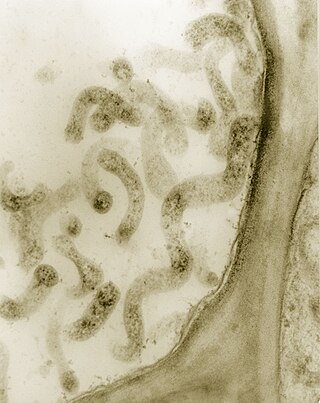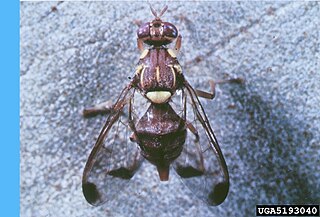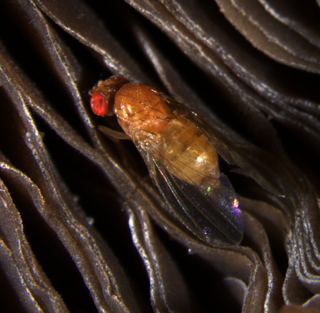Related Research Articles

The Tachinidae are a large and variable family of true flies within the insect order Diptera, with more than 8,200 known species and many more to be discovered. Over 1,300 species have been described in North America alone. Insects in this family commonly are called tachinid flies or simply tachinids. As far as is known, they all are protelean parasitoids, or occasionally parasites, of arthropods, usually other insects. The family is known from many habitats in all zoogeographical regions and is especially diverse in South America.

Spiroplasma is a genus of Mollicutes, a group of small bacteria without cell walls. Spiroplasma shares the simple metabolism, parasitic lifestyle, fried-egg colony morphology and small genome of other Mollicutes, but has a distinctive helical morphology, unlike Mycoplasma. It has a spiral shape and moves in a corkscrew motion. Many Spiroplasma are found either in the gut or haemolymph of insects where they can act to manipulate host reproduction, or defend the host as endosymbionts. Spiroplasma are also disease-causing agents in the phloem of plants. Spiroplasmas are fastidious organisms, which require a rich culture medium. Typically they grow well at 30 °C, but not at 37 °C. A few species, notably Spiroplasma mirum, grow well at 37 °C, and cause cataracts and neurological damage in suckling mice. The best studied species of spiroplasmas are Spiroplasma poulsonii, a reproductive manipulator and defensive insect symbiont, Spiroplasma citri, the causative agent of citrus stubborn disease, and Spiroplasma kunkelii, the causative agent of corn stunt disease.

A black fly or blackfly is any member of the family Simuliidae of the Culicomorpha infraorder. It is related to the Ceratopogonidae, Chironomidae, and Thaumaleidae. Over 2,200 species of black flies have been formally named, of which 15 are extinct. They are divided into two subfamilies: Parasimuliinae contains only one genus and four species; Simuliinae contains all the rest. Over 1,800 of the species belong to the genus Simulium.

Insect ecology is the interaction of insects, individually or as a community, with the surrounding environment or ecosystem.

Bactrocera cucurbitae, the melon fly, is a fruit fly of the family Tephritidae. It is a serious agricultural pest, particularly in Hawaii.

The immigrans-tripunctata radiation is a speciose lineage of Drosophila flies, including over 300 species. The immigrans-tripunctata radiation is a sister lineage to most other members of the subgenus Drosophila. A number of species have had their genomes or transcriptomes sequenced for evolutionary studies using Drosophila.

Howardula aoronymphium is a species of nematode that infects specialist mushroom-feeding fruit flies such as Drosophila falleni and Drosophila neotestacea. Mated female nematodes pierce the fly larva cuticle and take up residence in the hemolymph where they mature alongside the fly. When the adult fly ecloses, the nematode motherworm has reached full size and sheds juvenile nematodes into the hemolymph which are eventually excreted by either the fly anus or ovipositor. Howardula nematodes can severely impact fly egg development, as infection can effectively sterilize some species.

Drosophila neotestacea is a member of the testacea species group of Drosophila. Testacea species are specialist fruit flies that breed on the fruiting bodies of mushrooms. These flies will choose to breed on psychoactive mushrooms such as the Fly Agaric Amanita muscaria. Drosophila neotestacea can be found in temperate regions of North America, ranging from the north eastern United States to western Canada.

The Drosophila testacea species group belongs to the Immigrans-tripunctata radiation of the subgenus Drosophila, and contains 4 species: Drosophila putrida, Drosophila neotestacea, Drosophila testacea, and Drosophila orientacea. Testacea species are specialist mushroom-feeding flies, and can metabolize toxic compounds in Amanita mushrooms. The Testacea species group is studied for its specialist ecology, population genetics, and bacterial endosymbionts. The North American species Drosophila neotestacea is perhaps the best-studied of the group for its interactions with parasitic wasps and nematodes, bacterial endosymbionts, and trypanosomatid parasites. Of note, selfish X chromosomes have been discovered in three of the four Testacea group species.
Spiroplasma poulsonii are bacteria of the genus Spiroplasma that are commonly endosymbionts of flies. These bacteria live in the hemolymph of the flies, where they can act as reproductive manipulators or defensive symbionts.
The mushroom phorid fly(Megaselia halterata) is a species of scuttle fly or hump-backed flies in the family Phoridae. "The mushroom phorid" is also used to refer to M. halterata. Megaselia halterata is a common pest of mushroom cultivation, attracted by the aroma of developing fungal mycelium. The larvae damage both the mushroom mycelium and gill tissues. Megaslia halterata can be found worldwide.

Howardula is a genus of nematode that infests the larvae of mushroom-feeding flies, beetles, and other insects. Various Howardula species and strains infest mushroom-feeding Drosophila, including Howardula aoronymphium and Howardula neocosmis. Howardula husseyi can infest the mushroom phorid Megaselia halterata.

The Drosophila quinaria species group is a speciose lineage of mushroom-feeding flies studied for their specialist ecology, their parasites, population genetics, and the evolution of immune systems. Quinaria species are part of the Drosophila subgenus.

Mushroom-feeding Drosophila are a subset of Drosophila flies that have highly specific mushroom-breeding ecologies. Often these flies can tolerate toxic compounds from Amanita mushrooms.

Drosophila innubila is a species of vinegar fly restricted to high-elevation woodlands in the mountains of the southern USA and Mexico, which it likely colonized during the last glacial period. Drosophila innubila is a kind of mushroom-breeding Drosophila, and member of the Drosophila quinaria species group. Drosophila innubila is best known for its association with a strain of male-killing Wolbachia bacteria. These bacteria are parasitic, as they drain resources from the host and cause half the infected female's eggs to abort. However Wolbachia may offer benefits to the fly's fitness in certain circumstances. The D. innubila genome was sequenced in 2019.
Jaenimonas drosophilae is a trypanosomatid parasite of mushroom-feeding flies, first characterized in Drosophila neotestacea and Drosophila falleni. Jaenimonas takes up residence in the gut of the fly, and infection leads to reduced fecundity of its fly host. The species is named for John Jaenike, a prominent ecologist and evolutionary biologist whose work on mushroom-feeding flies laid the foundation for studies on mycophagous Drosophila.
Jaenimonas is a genus of trypanosomatid parasite that infects mushroom-feeding Drosophila, similar to Crithidia parasites of Bumblebees. Jaenimonas drosophilae is the sole representative of this genus. The genus is named in honor of John Jaenike, a prominent ecologist and evolutionary biologist whose work on mushroom-feeding flies laid the foundation for studies on mycophagous Drosophila. Jaenike was also an early proponent of the Red Queen hypothesis.

Drosophila phalerata is a species of mushroom-feeding fruit fly in the Drosophila quinaria species group. The genome of D. phalerata was sequenced in 2019 as part of a study on the evolution of immune systems, but was not assembled de novo.

Allantonematidae is a family of insect-parasitic nematodes from the order Tylenchida. Allantonematid nematodes infect a variety of insects including beetles, butterflies, flies, thrips, ants, and more. For instance, the nematode Howardula aoronymphium parasitizes mushroom-feeding fruit flies, Formicitylenchus oregonensis parasitizes carpenter ants, and Metaparasitylenchus hypothenemi parasitizes a pest of coffee beans, the coffee berry borer.

Lutzomyia longipalpis is a species complex of sandfly belonging to the family Psychodidae. This species is primarily present in Central and South America, but has also appeared in Mexico. There have been reports of L. longipalpis as far south as Argentina, as they are found in a wide variety of ecological conditions. Both males and females feed on sugars from plants and aphids, but only adult females feed on the blood of other mammals. The species has recently begun appearing in urban areas throughout Brazil, and serves as a key vessel for the propagation of the parasite Leishmania infantum. The presence of these flies appears to be strongly correlated to the presence of domestic chickens in Latin America. The first major urban outbreak of the lethal Visceral leishmanias epidemic was detected in Teresina, Piauí State in the early 1980s following a massive planting of acacias.
References
- ↑ Grimaldi D. (1985). "Niche separation and competitive coexistence in mycophagous Drosophila (Diptera: Drosophilidae)". Proceedings of the Entomological Society of Washington. 87 (3): 498–511.
- ↑ Bunyard B. (2003). "Biodiversity and ecology of mycophagous Diptera in Northeastern Ontario". Proceedings of the Entomological Society of Washington. 105 (4): 847–58.
- ↑ Jaenike J, Anderson TJC. (1992). "Dynamics of host-parasite interactions: the Drosophila–Howardula system". OIKOS. 674 (3): 533–40. doi:10.2307/3545172. JSTOR 3545172.
- ↑ Cevallos, James A.; Okubo, Ryo P.; Perlman, Steve J.; Hallem, Elissa A. (2017). "Olfactory Preferences of the Parasitic Nematode Howardula aoronymphium and its Insect Host Drosophila falleni". Journal of Chemical Ecology. 43 (4): 362–373. doi:10.1007/s10886-017-0834-z. PMC 5673469 . PMID 28315996.
- ↑ Hill, Tom; Koseva, Boryana S; Unckless, Robert L; Singh, Nadia (13 March 2019). "The genome of Drosophila innubila reveals lineage-specific patterns of selection in immune genes". Molecular Biology and Evolution. 36 (7): 1405–1417. doi: 10.1093/molbev/msz059 . PMC 6573480 . PMID 30865231.